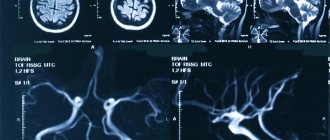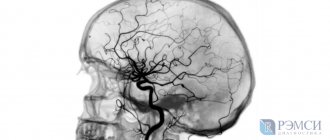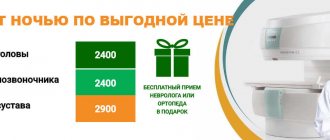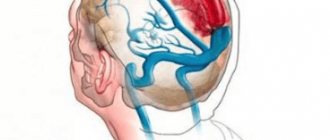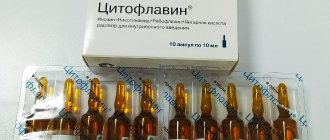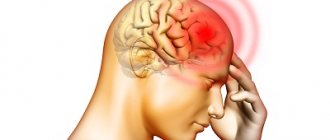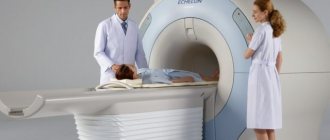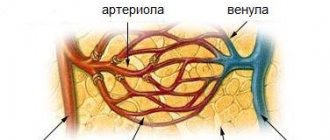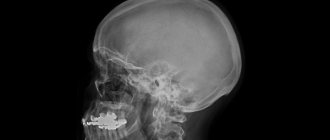The rhythm of our lives, constant stress and working at the limit of our capabilities significantly undermine our health. This overload is manifested by frequent headaches, decreased concentration of memory and attention, and a drop in body tone. Circulatory disorders often occur, and if previously insufficient blood supply to the brain was the prerogative of older people, now similar disorders are observed in young people and even children. Malfunctions of the blood vessels in the brain and neck can cause serious consequences: migraines, insufficient efficiency of brain activity, heart attack, stroke, aneurysm. To avoid such sad consequences, you need to know how to check the blood vessels of the brain.
When should you get tested?
Seeing a doctor
If there are complaints, the doctor will decide which examination method to use in a particular case. The specialist takes into account the symptoms and manifestations of illness. The following points are taken into account:
- patient complaints of frequent headaches, migraine attacks or dizziness;
- head or cervical spine injuries are taken into account;
- periodic tinnitus;
- sudden changes in vision or hearing;
- nosebleeds;
- episodic fainting and loss of consciousness;
- symptoms of chronic ischemia;
- history of cerebral infarction;
- trembling of hands and head;
- pressure changes, high or low readings;
- painful sensations in the cervical region and a feeling of pulsation;
- unsteady gait or balance problems;
- suspected brain tumor;
- suspicion of a vessel aneurysm.
Early diagnosis will help identify the threat of a stroke, identify neoplasms, determine the severity of damage to arterial walls, find out the degree of concussion, and the fact of cerebral infarction.
Diagnosis of the condition of the arteries and veins will help the attending physician correctly prescribe a set of therapeutic measures, and, if necessary, recommend surgical intervention. Sometimes a specialist prescribes a study of the vascular system of the neck and spine. Some patients do not understand the need for this diagnosis. It is in these places that the main arterial branches leading to the brain pass. Disturbances in the peripheral areas of the vascular systems affect the condition of the brain vessels as a whole. Let's look at how to check the vessels of the head, how a patient is examined, and what a check of the blood vessels reveals.
Read
Features of cleaning blood vessels with folk remedies
Treatment and prevention
To diagnose vascular diseases of the head or neck, you can contact a neurologist, a cardiologist will prescribe a check of the heart vessels, and an angiologist will prescribe a study of arteries and veins (to diagnose varicose veins). To receive a referral to any of the doctors, you can contact your primary care physician.
Treatment and prevention of vascular diseases of the heart and brain:
- Complete smoking cessation;
- Healthy balanced diet (whole grains, low-fat dairy products, protein foods - lean meat, poultry, seafood, soy products, nuts, seeds, peas, legumes);
- Moderate alcohol consumption;
- Regular physical activity (helps get rid of cholesterol plaques);
- Maintaining normal weight;
- Avoidance of emotional stress;
- Drug and hormonal therapy;
- Angioplasty, coronary bypass surgery (against the background of severe vascular diseases);
- Cardiac rehabilitation programs.
To prevent vascular problems, you can use:
- Alternative medicine (treatment with folk remedies using grapes, horse chestnut, sweet clover, beets, nettles, clover);
- Carrying out regular cleanings of blood vessels (to lower cholesterol levels) both in a hospital and independently using traditional medicine;
- Taking medications prescribed by a doctor (statins, fibrates, bile acid sequestrants, vitamins PP, A, C, E, K, vasodilators, venotonics);
- A diet high in foods such as beets, carrots, citrus fruits, garlic, onions, honey, lean poultry and fish, as well as dried fruits (dried apricots, prunes, raisins).
Options for research methods of cerebral vessels
To answer the question of how to check the condition of blood vessels, let’s consider existing methods. The entire group of vascular research methods is divided into two subtypes:
- non-invasive;
- invasive.
The latter - invasive - is a method of research with immersion into the cavity of the vessel.
Neurosonography
You can examine the vessels and make a conclusion about their state of health using the following diagnostic methods:
- NSG – neurosonography. This study is applicable to children under one year of age. It is prescribed to monitor the health of blood vessels and the fluid-excreting system after a traumatic birth, hypoxia during childbirth or in the womb.
- DS – duplex scanning. The newest method that allows, using ultrasound, to identify the initial stage of stenosis, atherosclerosis, to identify an aneurysm or pathological changes in the vascular system of the brain. The image is displayed in color, with arteries and veins clearly visible.
- REG – rheoentselography. The study is carried out using electrodes and low current. This method allows you to determine the speed of blood flow in the vessels, the patency of the blood flow, the diameter of the lumen, the integrity and elasticity of the venous and arterial walls.
Double research
There are techniques that allow you to examine the neck veins and vessels of the head simultaneously.
MRI
This will help identify abnormalities in the early stages and help the patient stabilize the condition:
- EEG – echoencephalography. The examination procedure is carried out without prior special preparation, is non-traumatic and painless. The study reveals the condition of the veins, arteries of the neck and head, and identifies the source of intracranial pressure. This method is used when the development of a brain tumor is suspected, with impaired blood supply, purulent pathological courses of the disease and blood accumulations.
- Ultrasound Dopplerography. Using the method, the speed of blood flow through the vascular channels of the neck and head is determined, the diameter and fullness are determined. Used for atherosclerosis to determine the severity of vascular lesions and blockages.
- USG - ultrasonography. The technique helps to examine the arterial vessels of the head and neck for the presence of blood clots, deposits of fatty fractions and fibronodules on the walls of the vessels.
- CT – computed tomography. This method allows you to scan organs layer by layer and identify pathological changes in the condition of the arteries and veins of the brain.
- MRI – magnetic resonance imaging. An effective method for studying the conditions of the vascular system and parts of the brain, but it has some contraindications: excess body weight over one hundred and fifty kilograms, the presence of pacemakers and implants in the body.
Read
Why take medications for blood vessels?
What is the price?
The cost of the examination depends on the examination method that the attending physician prescribed for the patient. The cost of the study varies on average from 600 rubles to 7,500 rubles.
To summarize, we can say that in case of any unclear health conditions, it is best for the patient to immediately contact a qualified doctor who, after an in-person consultation, will give the patient a referral for examination.
After all, a disease is always easier to cure at an early stage than when it is already advanced. Therefore, despite being busy, every person needs to first of all monitor their well-being. After all, timely seeking medical help can not only improve the patient’s condition, but also, in extreme cases, save his life.
Invasive vascular research options
As already mentioned, invasion is penetration. These methods allow you to learn about the condition of blood vessels from the inside.
Computed angiography
The following methods are known:
- CA – computed angiography. To carry out the procedure, local anesthesia is given and a special substance is injected into the artery to allow contrast images to be taken. This method identifies various pathologies: cysts, blood clots, aneurysms or oncological tumors. The technique is also applicable during preparation for neurosurgical interventions. There are a number of contraindications to the use of the method: mental illness, gestation period, breastfeeding period, iodine intolerance, poor blood clotting.
- MRA – magnetic resonance angiography. It is carried out in two options: with and without contrast. Using the method, they determine how damaged the brain is after a stroke, the causes of increased intracranial pressure, developmental pathologies and the presence of tumors.
Taking into account the disease of the subject and the severity of the disorder, the neurologist prescribes one or another diagnosis. Studies involving penetration into the inside of an organ are carried out only in a hospital or center; other types of diagnostics can be carried out in a hospital setting. A blood test to examine the state of vascular health is prescribed every time you visit a doctor. What will such a study show?
A clinical blood test itself does not directly answer the state of the vascular system, but will provide indirect information about the extent of damage and the cause of the disease. For example, atherosclerosis is the main cause of damage to the vascular system. A blood test will show high levels of low-density lipoproteins, and this, in turn, will indicate changes in the arteries of the brain.
Systemic vasculitis, blood clotting disorders, and a tendency to form blood clots are also detected.
Electrical measuring method
The procedure, called electroencephalography (EEG), is done by using an electroencephalograph. This device, which records changes in the electrical potential of different nuclei of the brain and the potential of neurons, examines the circulatory system of the vessels of the neck and head in a comprehensive manner. The method has broad capabilities and allows you to determine not only congenital and acquired vascular anomalies, but also their effect on brain tissue.
An electroencephalogram (a tape that records all changes) accurately shows which areas of the brain and to what extent experience oxygen starvation and do not receive adequate nutrients. You can also obtain reliable information about the level of functioning of brain cells and blood vessels.
The procedure is absolutely safe, so it is recommended for use by patients of all ages: both elderly people and small children. A significant advantage of electroencephalography is its availability and low cost (if it is done in a private medical office). It takes about 15 minutes, but in some cases it can take several hours.
Checking the blood vessels should be preceded by certain preparation: stop taking anticonvulsants and antispasmodics. The patient's scalp and hair must be clean at the time of the procedure.
The effectiveness of vascular examination
Patients often ask what pathologies are detected as a result of checking blood vessels. Conventionally, violations can be divided into the following groups:
- vascular abnormalities;
- vascular pathologies;
- volumetric processes.
Read
About the treatment of cerebral vessels using traditional methods
Vascular anomalies include the following diseases:
- pathological expansion of the vessel body (aneurysm);
- malformation (congenital disorder in the connection of the venous and arterial structures);
- fistula (pathological post-traumatic connection between a vein and an artery).
Vascular pathologies include stenosis, rupture and thrombosis of blood vessels.
Benign tumor
Also, the result of the study may be the identification of extensive pathological processes. The following violations are identified:
- benign tumors;
- malignant tumors;
- accumulation of pus - abscess;
- accumulation of blood - hematoma.
Electroencephalography
Recording electrical activity of the brain. Indirectly reflects changes in the blood supply to individual structures. In the study of blood vessels it is used only as an additional method.
Procedure technique:
- a helmet with electrical sensors is fixed on the head, which record the electrical impulse activity of the brain;
- During the procedure, a number of tests are carried out (light, noise, breathing)
Electroencephalographic study and its results
| Contraindications | Preparation | Time (min) |
| Mental disorders in the acute period Early childhood Psychotrauma during the period of emotional instability | Do not use stimulants within 12 hours before the test (nicotine, coffee, energy drinks) Wash your hair, do not use styling products Eating no later than 2 hours before the procedure | 45–120 |

